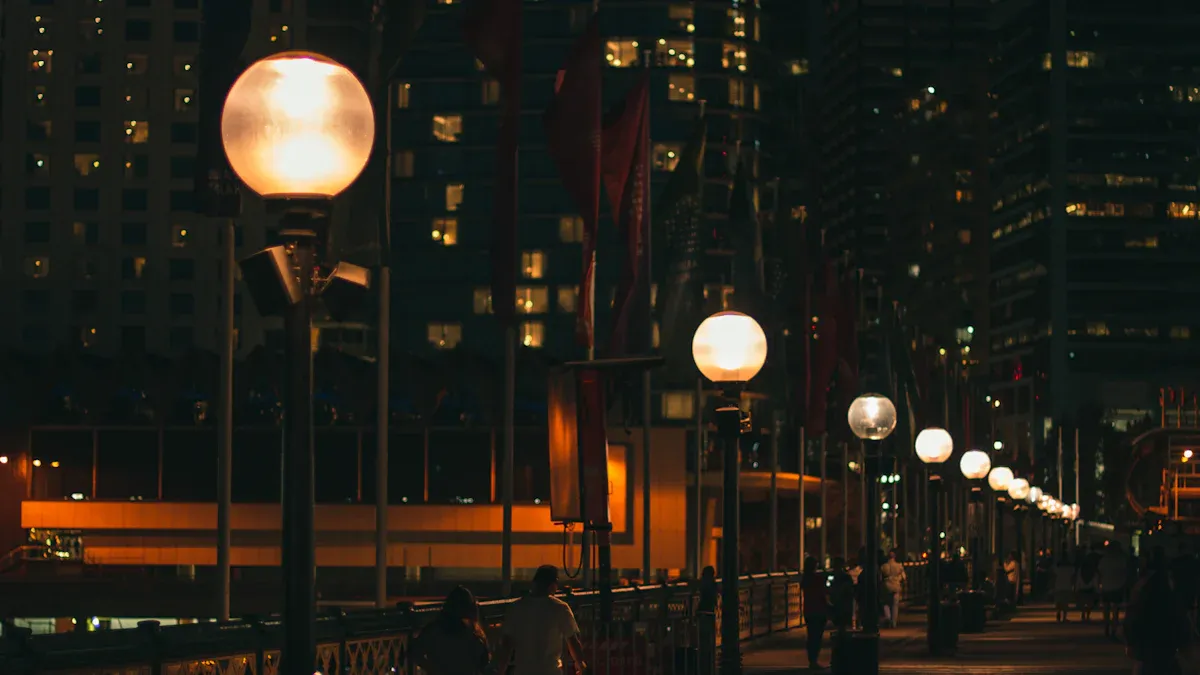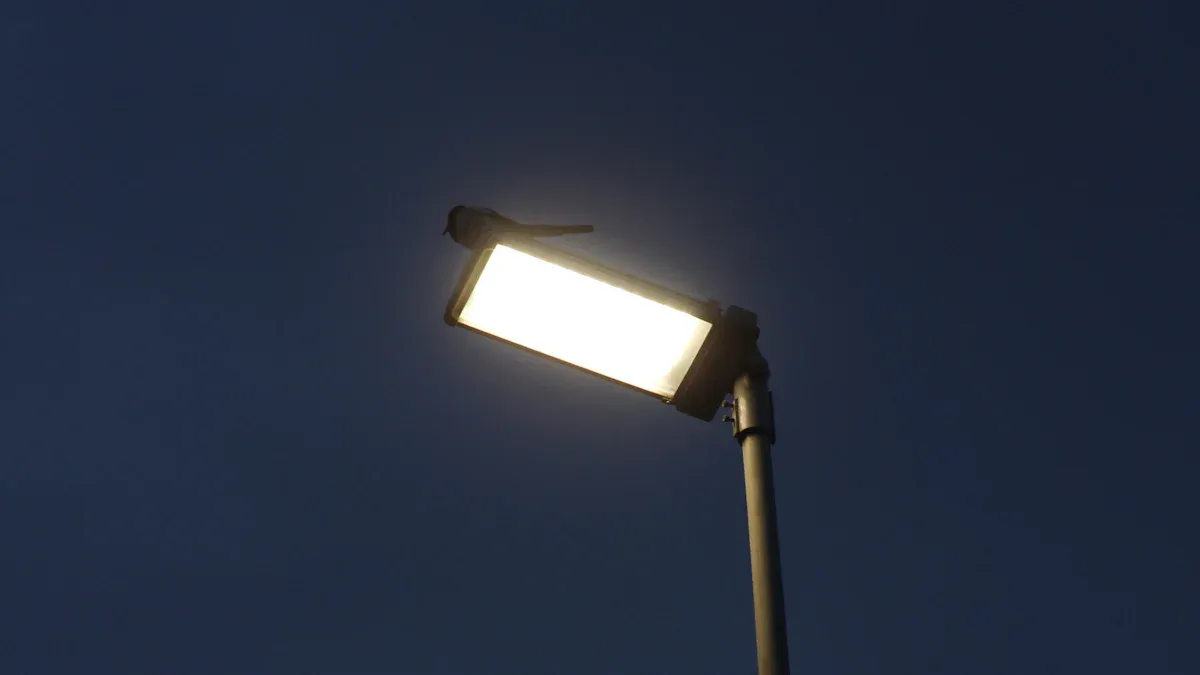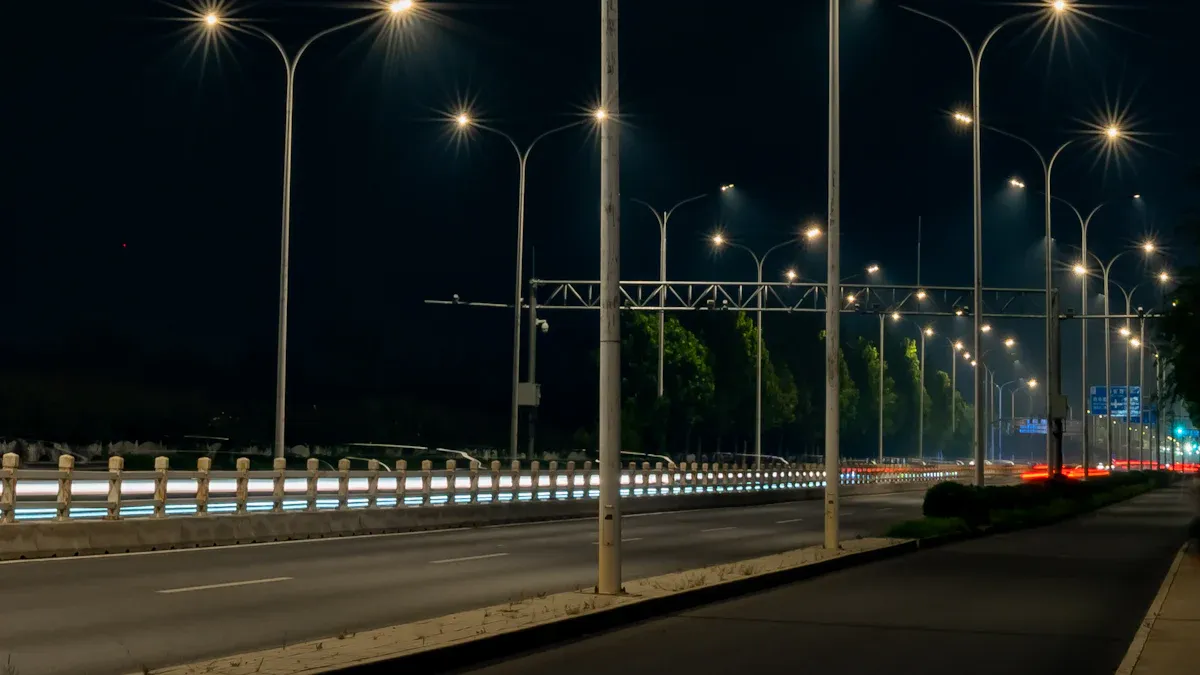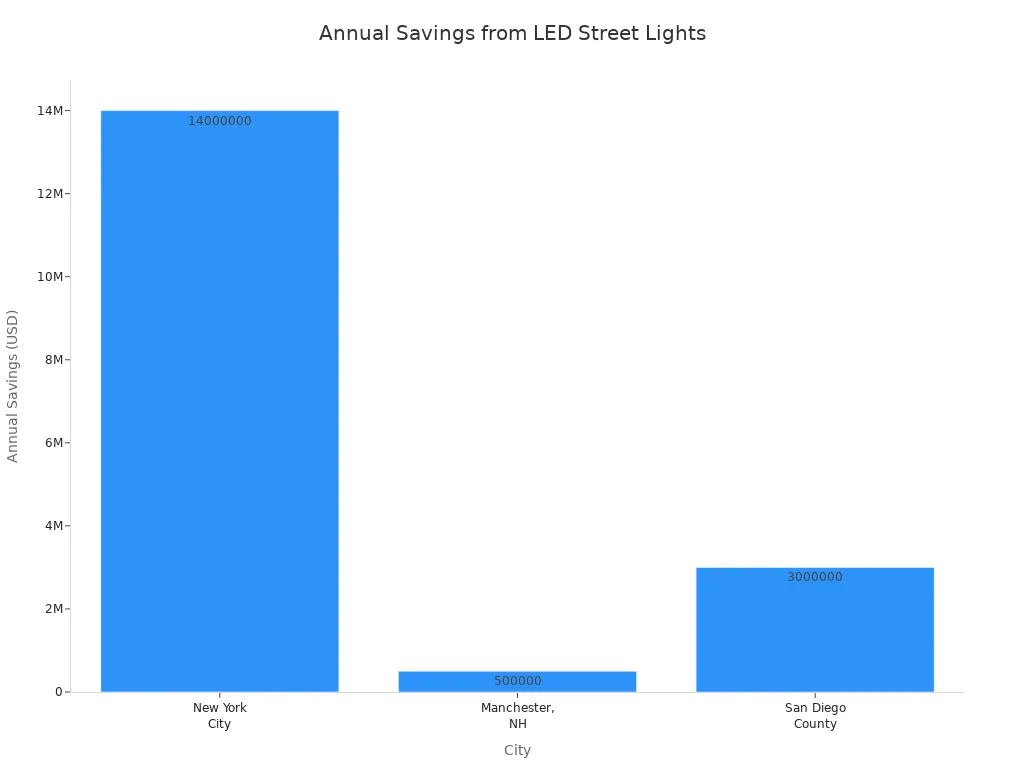LED Street Lights: Technology, Benefits, and Implementation

Lighting is important for safe streets and friendly neighborhoods. LED Street Lights use new Led Light technology. They make roads and public places brighter. They also use less energy than old lights. If you pick these lights for your home or city, you save money. You can cut energy bills by up to 70%. You also spend less on repairs. Many cities now save money and help the planet. Many Product suppliers talk about these good things on their About Us pages. This makes LED street lights a smart choice for all.
Key Takeaways
LED street lights use less energy and save money. Changing to them can lower energy bills by up to 70%.
These lights work longer than old types. They can last from 25,000 to 200,000 hours. This means less waste.
LED street lights help keep people safe. They give off bright, clear light. This makes it easier to see at night.
Smart features make them work better. Sensors can change how bright the lights are. They do this based on traffic and sunlight.
Picking LED street lights helps the environment. They cut down carbon emissions and lower light pollution.
What Are LED Street Lights

Definition
You see LED Street Lights on roads, highways, and public spaces. These lights use LED technology to shine bright and clear. Industry standards define LED road lights as those with power greater than 30 watts and a semiconductor light source. When you choose these lights, you get:
Uniform lighting that meets road safety needs.
A light conversion rate of 17%.
Average illuminance uniformity of 0.48, so light spreads evenly.
A rated average life of at least 30,000 hours, which means fewer replacements.
High protection levels, such as IP67, IP66, or IP65, to guard against dust and water.
A power factor of at least 0.92, which shows strong energy performance.
Surge suppression to protect against electrical spikes.
Note: These features help you get reliable and safe lighting for your streets.
Key Features
LED Street Lights stand out because they offer many benefits that older lights cannot match. Here is a table that shows the most important features and what they mean for you:
Feature | Description |
|---|---|
Instant On/Off | Lights turn on right away, so you never wait for full brightness. |
Directional Lighting | Light shines where you need it, which cuts down on wasted light and glare. |
Color Rendering | You see colors clearly, making it easier to spot people and objects. |
Dimmability | You can adjust brightness to save energy or fit special needs. |
Uses less electricity, which lowers your bills and helps the environment. | |
Longevity | Lasts from 25,000 to 100,000 hours, so you replace bulbs less often. |
When you use LED Street Lights, you get better safety, lower costs, and a greener choice for your community.
LED Street Lights Technology
Components
When you look at LED Street Lights, you see more than just a bulb. Each fixture has several important parts that work together to give you bright and reliable light. Here are the main components:
LED street light bulbs create the main source of light. They decide how bright your street will be.
The pole holds the fixture high above the ground. This helps the light spread over a wide area.
An optical lens and light distribution system control where the light goes. These parts reduce glare and make sure the light covers the right spots.
The LED driver manages the power that goes to the bulbs. It keeps the light steady and safe.
A heat sink pulls heat away from the LEDs. This keeps the lights cool and helps them last longer.
Note: Each part plays a key role in making sure your streets stay well-lit and safe.
How LEDs Work
LEDs use a special process called electroluminescence. When electricity moves through a tiny chip made of semiconductor material, the chip gives off light. This process uses much less energy than old-style bulbs. For example, LEDs can use up to 80% less electricity than traditional lights but still shine just as bright. Most of the energy turns into light, not heat. Incandescent bulbs waste about 90% of their energy as heat, but LEDs turn up to 95% into light. This means you save money and get lights that last 25 to 50 times longer.
Smart Features
Modern LED Street Lights often come with smart features that help you save even more energy and improve safety. Some lights have sensors that change brightness based on how much natural light is around. Others use motion detectors to get brighter when people or cars pass by. You might also find cameras and sensors that watch traffic or check air quality. Many systems let you control the lights from far away using remote controls or automation. These smart features help you manage lighting better and keep your community safe.
Benefits of LED Street Lights
Energy Efficiency
Switching to LED Street Lights saves a lot of energy. These lights use much less power than old street lights. The table below shows how much energy you can save:
Type of Light | Power Consumption (Watts) | Energy Savings (%) |
|---|---|---|
Traditional (High-Pressure Sodium) | 100 | N/A |
LED | 30-50 | 50% |
Cities that use LED Street Lights use much less electricity. For example, Los Angeles changed over 140,000 street lights. They cut their energy use by 63%. Dimming lets you lower the lights at night. This saves even more energy. Directional lighting means you only light up needed areas. You do not waste energy lighting empty spaces. Using LED Street Lights helps your city use less power and pay lower bills.
Cost Savings
LED Street Lights help you save a lot of money. They cost more at first, but you save over time. These lights use less energy and break less often. Most cities get their money back in three to five years. Old street lights cost more because they use more power. They also need new bulbs more often. With LED Street Lights, you spend less on energy and repairs.
Longevity
LED Street Lights last much longer than old lights. The table below shows how long each type lasts before you need a new one:
Light Source | Average Lifespan (hours) |
|---|---|
LED | 25,000 - 200,000 |
High-Pressure Sodium | 24,000 |
Low-Pressure Sodium | 18,000 |
Longer life means you do not change bulbs as much. This makes less trash and saves resources. The table below shows how this helps the environment:
Aspect | LED Street Lights |
|---|---|
Longevity | Longer life means fewer replacements |
Waste Generation | Less trash helps the environment |
Resource Consumption | Uses fewer materials and less disposal |
You help the planet by making less trash and using fewer materials. Many LED street lamps last over 100,000 hours. This is more than 16 times longer than some other lamps.
Safety and Light Quality
LED Street Lights make streets safer for everyone. They give off bright, clear light so you can see better at night. The color rendering index (CRI) shows how well a light shows colors. A higher CRI means you see colors more clearly. The table below shows how CRI affects safety:
CRI Value | Effect on Visibility and Perception |
|---|---|
High (≥80) | High CRI helps you see people, cars, and signs. This makes streets safer and more comfortable. |
Low (<70) | Low CRI makes colors look wrong. This can make it hard to trust what you see. It is less safe for drivers and walkers. |
When you walk or drive under LED Street Lights with high CRI, you see people, cars, and signs better. This helps you feel safer and can stop accidents. Many people say roads with high CRI lights are easier to see and use.
Environmental Impact
LED Street Lights help the environment in many ways. They use less energy, so there is less pollution from power plants. The table below shows how much carbon emissions can drop when cities use LED Street Lights:
Source | Energy Reduction | CO2 Reduction |
|---|---|---|
LED Streetlights | 50% energy use | 2 million pounds each year |
LA County Public Works | 45% energy use | 16 million kilowatt-hours each year |
Concord, NH | Less energy used | 551.6 tons each year |
LED Street Lights also help stop light pollution. They use special optics to shine light only where it is needed. This cuts down on glare and keeps the night sky darker. Directional lighting and good optics make sure you do not waste light or energy.
Tip: When you pick LED Street Lights, you help make your community cleaner, safer, and better for the future.
Implementing LED Street Lights

Selection Criteria
When you choose LED Street Lights for your community, you need to look at several important factors. The table below shows what you should consider:
Criteria | Description |
|---|---|
Visibility and Efficiency | Make sure the lights improve how well you see at night and save energy. |
Resilience | Pick lights that make your city’s lighting system stronger and more reliable. |
Long-term Cost Reduction | Look for options, like solar-powered lights, that save money over time. |
Climate and Equity Goals | Choose lights that help your city meet climate and fairness goals. |
You should also:
Talk with local groups to get their support.
Follow your city’s lighting rules.
Check if the lights meet emission standards.
Tip: Picking the right lights helps your city stay safe, save money, and protect the environment.
Installation
You need to plan the installation step by step. First, check the area and decide where to put each light. Make sure the poles are strong and in good shape. Use skilled workers to set up the lights and connect the power safely. Always test the lights before you finish the job. Good planning and careful work help you avoid problems later.
Smart and Solar Options
Smart and solar-powered LED Street Lights give you more benefits. The table below compares these options:
Feature | Smart Solar-Powered LED Street Lights | Traditional LED Lights |
|---|---|---|
Installation Cost | Higher (needs solar panels, batteries) | Lower |
Ongoing Costs | No electric bills, less upkeep | Pays for power and repairs |
Maintenance | Needs little care | Needs regular care |
Lifespan | Lasts longer | Shorter life |
Eco-friendliness | Very eco-friendly | Less eco-friendly |
Smart solar lights use sensors and remote controls. You can check and change them from far away. They last longer and cost less to run. These lights work well in places without easy access to power.
Maintenance
To keep your lights working well, you should:
Inspect them often to spot problems early.
Clean the lights to remove dust and dirt.
Check poles for rust or damage.
Use smart systems to find and fix issues fast.
Track energy use and repairs with smart tools.
Note: Regular care helps your LED Street Lights last longer and shine brighter.
Case Studies
Community Success Stories
You can see how LED street lights help by looking at what cities have done. Many places changed to LED lighting and got big rewards. The table below shows how some large cities made their streets better and saved energy:
City | Description | Benefits Achieved |
|---|---|---|
Miami | Put in almost 500,000 connected LED streetlights to lower emissions. | 25% drop in CO₂ emissions by 2020 |
Madrid | Changed 225,000 streetlights with remote control features. | 44% yearly energy savings |
Los Angeles | Set up 110,000 smart streetlights as city hubs. | Helps IoT and noise checks |
Jakarta | Used wireless tech for connected LED streetlights. | 70% yearly energy savings |
You can also see success by checking how much money cities save each year. The chart below shows yearly savings from LED street light projects in some U.S. cities:

For example, New York City saves $14 million every year and says the light is better and streets are safer. Manchester, NH saves $500,000 and spends less on fixing lights. Asheville, NC has cut greenhouse gases and started a fund for future energy-saving work. These stories show you can get real results by picking LED street lights.
Lessons Learned
When you plan a big LED street light project, you can learn from what other cities did. Here are some key lessons:
You must balance old buildings with new tech to keep your city’s look.
Careful planning helps you know what lights you need and where to put them.
Smart tech gives you better energy use and more value.
Talking with the community gets people to support the project and learn the benefits.
Setting up drivers at the factory and testing on-site makes upgrades work better.
Tip: Always talk to your community early and test your lights before you finish the job.
You should also watch out for common problems. Many cities have had these issues:
Product claims that are not true
Fake chips and power supplies
Using copper wires instead of gold in LEDs
Bad lens design and weak light spread
Poor heat control
Power problems
Security risks
Harmful stuff that makes LEDs not last as long
By learning from these stories, you can make better choices and not waste money. Your city can have safer, brighter, and more efficient streets.
You get lots of good things when you pick LED Street Lights for your town. The table below shows the top benefits:
Advantage | Description |
|---|---|
Energy Efficiency & Savings | They use much less energy. This saves money and cuts pollution. |
Improved Safety | Brighter lights help people see better and stay safe. |
Long Lifespan | You change bulbs less often. This means less trash and less fixing. |
Smart Integration | You can link them to smart city tools. This helps you control and check lights easily. |
To begin, talk to experts and try out new lights. Make a plan to care for the lights for many years. As cities get smarter, you will see more cool features. These include lights that change brightness and sensors that watch the environment. These things help keep streets safe and protect nature.
FAQ
What makes LED street lights better than old street lights?
You get brighter light and use less energy with LEDs. These lights last longer and need fewer repairs. You also save money over time. LED street lights help your city become safer and more eco-friendly.
Can LED street lights work with solar power?
Yes, you can use solar panels with LED street lights. Solar-powered LEDs store energy during the day and shine at night. You do not need to connect them to the main power grid.
Do LED street lights cause more glare or light pollution?
No, LED street lights use special optics. They direct light only where you need it. This reduces glare and keeps the night sky darker. You help cut down on light pollution in your area.
How do you control or dim LED street lights?
You can use smart controls to dim or brighten LED street lights. Some systems let you change settings from your phone or computer. Sensors can also adjust brightness based on traffic or daylight.
See Also
Exploring Advantages and Innovations of LED Street Lighting
Modern LED Street Bulbs: Efficiency, Longevity, and Installation Perks
In-Depth Overview of LED Street Light Innovations

